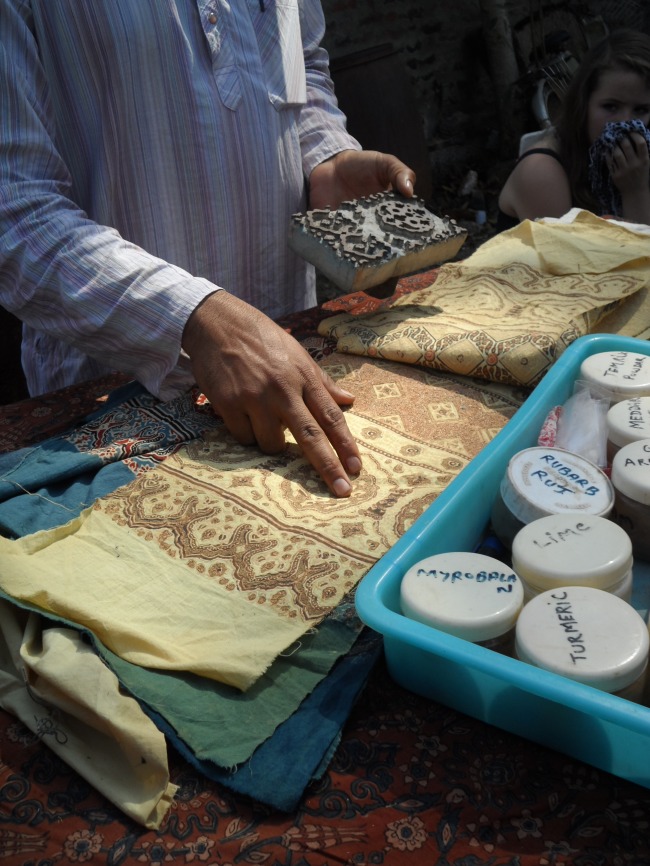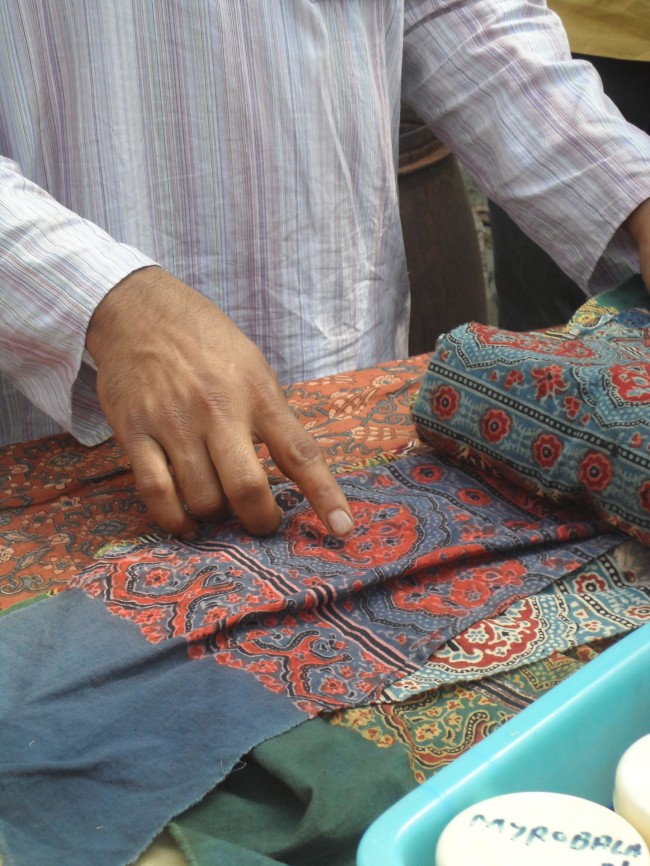block printing
Block printing
Block printed fabric is such an amazing form of decoration. I was lucky enough to meet artists, who were more than willing to show me their work process and products.
Sofian is a tenth generation artisan, invited by the king of Kutch; he specializes in Ajrajh. The work he produces is known as Ajrakh, the entire process of which takes sixteen days. He has many traditional designs using a lot of natural dyes, as well as synthetics such as using synthetic indigo (this all depends on the market). Sofian’s grandfather revived natural dyes in 1945. They are working on reviving older designs, researching a lot of them at the V&A in London. Falag patterns are from their particular region. They have patterns on blocks going back 9 generations.  The process begins with white cloth which is washed with sod, camel dung and castor oil. It is soaked overnight and then washed with running water. The fabric is then washed with ground myrobalan nut powder and then dried in the sun to fix the colour. The chosen design is printed onto the fabric with an Arabic gum and lime mixture (an alkaline). Black colour is added to the design. This is made using rust iron which has been left in water for two weeks then printed.
The process begins with white cloth which is washed with sod, camel dung and castor oil. It is soaked overnight and then washed with running water. The fabric is then washed with ground myrobalan nut powder and then dried in the sun to fix the colour. The chosen design is printed onto the fabric with an Arabic gum and lime mixture (an alkaline). Black colour is added to the design. This is made using rust iron which has been left in water for two weeks then printed.
The pattern appears printed on both sides. The blocks are made mainly from babool and teak. Some metal blocks are also used.
Indigo dye is applied next. Natural soda, made by burning lanayo plants, is added. Indigo is grown in July and harvested in October. It is no longer grown in Kutch region, but some is grown in the south. It can no longer be grown in Kutch as it has a negative effect on the environment, causing the land to go salty and making it impossible to grow other crops afterward. Dying with indigo requires a warm environment. If it is too hot or cold the dye process will not work. Direct indigo can also be made using leaves, lime, water and henna. This is then filtered and sugar is added.  The next area is printed with aluminium sulphate. This is an Eco friendly. Further design is printed with clay and alum-mud resist. Sawdust and wood powder used. Indigo, henna powder me lime used roe different colours. This is a two day process. The colour is tested mainly by taste, if there is a high level of alkaline a small amount of sugar is added. If the is less alkaline then cassiatora (lime water) is added to bring the balance of alkaline back.
The next area is printed with aluminium sulphate. This is an Eco friendly. Further design is printed with clay and alum-mud resist. Sawdust and wood powder used. Indigo, henna powder me lime used roe different colours. This is a two day process. The colour is tested mainly by taste, if there is a high level of alkaline a small amount of sugar is added. If the is less alkaline then cassiatora (lime water) is added to bring the balance of alkaline back.  When the water turns a green colour it is day to dye the fabric, which turns blue colours. The fabric is washed in plain water to remove gum etc. it is then washed in dyes, each producing a different effect. Alizarin is used for red, meddar nut powder for orange, rhubarb root for green. The fabric is then washed. Alum never leaves the fabric, allowing colour separation during washing. Traditional customers prefer deep colours. Multiple dying in indigo produces rich colours. Blue and red have been used in clothing for many years, they are known for being very useful for helping find people who are lost in the desert!
When the water turns a green colour it is day to dye the fabric, which turns blue colours. The fabric is washed in plain water to remove gum etc. it is then washed in dyes, each producing a different effect. Alizarin is used for red, meddar nut powder for orange, rhubarb root for green. The fabric is then washed. Alum never leaves the fabric, allowing colour separation during washing. Traditional customers prefer deep colours. Multiple dying in indigo produces rich colours. Blue and red have been used in clothing for many years, they are known for being very useful for helping find people who are lost in the desert!

Dying is, obviously, water dependent. Mudkar was chosen as a viable place to produce print work as it had a river. In the last 20-30 years the river has dried up so now they have big tanks of water. The earthquake caused a lot of iron presence in water, which is what instigated the move to Kutch. This is a farming area which also has a lot of iron in the ground, so now a traditional filtering system is in place, using charcoal and sand. As well as producing printed items, they also put on classes in the print room.
These can last anywhere between one week and 15 days.


